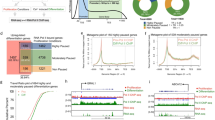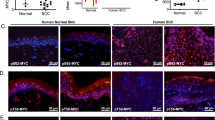Abstract
Recently, E2F function has expanded to include the regulation of differentiation in human epidermal keratinocytes (HEKs). We extend these findings to report that in HEKs, Sp1 is a differentiation-specific activator and a downstream target of E2F-mediated suppression of the differentiation-specific marker, transglutaminase type 1 (TG-1). Deletion of elements between −0.084 to −0.034 kb of the TG-1 promoter disabled E2F1-induced suppression of promoter activity. Electrophoretic mobility shift assays (EMSAs) demonstrated that Sp1 and Sp3 bound this region. Protein expression analysis suggested that squamous differentiation was accompanied by increased Sp1/Sp3 ratio. Cotransfection of proliferating HEKs or the squamous cell carcinoma (SCC) cell line, KJD-1/SV40, with an E2F inhibitor (E2Fd/n) and Sp1 expression plasmid was sufficient to activate the TG-1 promoter. The suppression of Sp1 activity by E2F in differentiated cells appeared to be indirect since we found no evidence of an Sp1/E2F coassociation on the TG-1 promoter fragment. Moreover, E2F inhibition in the presence of a differentiation stimulus induced Sp1 protein. These data demonstrate that (i) Sp1 can act as a differentiation stimulus, (ii) E2F-mediated suppression of differentiation-specific markers is indirect via Sp1 inhibition and (iii) a combination of E2F inhibition and Sp1 activation could form the basis of a differentiation therapy for SCCs.






Similar content being viewed by others
References
Andersen B, Schonemann MD, Flynn SE, Pearse II RV, Singh H and Rosenfeld MG . (1993). Science, 260, 78–82.
Apt D, Watts RM, Suske G and Bernard HU . (1996). Virology, 224, 281–291.
Banks EB, Crish JF, Welter JF and Eckert RL . (1998). Biochem. J., 331 (Part 1), 61–68.
Chen TT, Wu RL, Castro-Munozledo F and Sun TT . (1997). Mol. Cell. Biol., 17, 3056–3064.
Dahler AL, Cavanagh LL and Saunders NA . (2001). J. Invest. Dermatol., 116, 266–274.
Dahler AL, Jones SJ, Dicker AJ and Saunders NA . (1998). J. Cell. Physiol., 177, 474–482.
Di Stefano L, Jensen MR and Helin K . (2003). EMBO J., 22, 6289–6298.
Dicker AJ, Popa C, Dahler AL, Serewko MM, Hilditch-Maguire PA, Frazer IH and Saunders NA . (2000a). Oncogene, 19, 2887–2894.
Dicker AJ, Serewko MM, Dahler AL, Khanna KK, Kaur P, Li A, Strutton GM and Saunders NA . (2000b). Exp. Cell Res., 258, 352–360.
Dignam JD, Lebovitz RM and Roeder RG . (1983). Nucleic Acids Res., 11, 1475–1489.
Eckert RL, Crish JF, Banks EB and Welter JF . (1997a). J. Invest. Dermatol., 109, 501–509.
Eckert RL, Crish JF and Robinson NA . (1997b). Physiol. Rev., 77, 397–424.
Fajas L, Landsberg RL, Huss-Garcia Y, Sardet C, Lees JA and Auwerx J . (2002). Dev. Cell, 3, 39–49.
Guo CS, Degnin C, Fiddler TA, Stauffer D and Thayer MJ . (2003). J. Biol. Chem., 278, 22615–22622.
Guy CT, Zhou W, Kaufman S and Robinson MO . (1996). Mol. Cell. Biol., 16, 685–693.
Hagen G, Muller S, Beato M and Suske G . (1994). EMBO J., 13, 3843–3851.
Helin K, Lees JA, Vidal M, Dyson N, Harlow E and Fattaey A . (1992). Cell, 70, 337–350.
Jang SI and Steinert PM . (2002). J. Biol. Chem., 277, 42268–42279.
Jessen BA, Phillips MA, Hovnanian A and Rice RH . (2000). J. Invest. Dermatol., 115, 113–117.
Johnson-Pais T, Degnin C and Thayer MJ . (2001). Proc. Natl. Acad. Sci. USA, 98, 2211–2216.
Jones SJ, Dicker AJ, Dahler AL and Saunders NA . (1997). J. Invest. Dermatol., 109, 187–193.
Kadonaga JT, Carner KR, Masiarz FR and Tjian R . (1987). Cell, 51, 1079–1090.
Karlseder J, Rotheneder H and Wintersberger E . (1996). Mol. Cell. Biol., 16, 1659–1667.
Khanna KK, Beamish H, Yan J, Hobson K, Williams R, Dunn I and Lavin MF . (1995). Oncogene, 11, 609–618.
Kingsley C and Winoto A . (1992). Mol. Cell. Biol., 12, 4251–4261.
Lane EB, Bartek J, Purkis PE and Leigh IM . (1985). Ann. NY Acad. Sci., 455, 241–258.
Lania L, Majello B and De Luca P . (1997). Int. J. Biochem. Cell Biol., 29, 1313–1323.
Lee JH, Jang SI, Yang JM, Markova NG and Steinert PM . (1996). J. Biol. Chem., 271, 4561–4568.
Medvedev A, Saunders NA, Matsuura H, Chistokhina A and Jetten AM . (1999). J. Biol. Chem., 274, 3887–3896.
Park GT and Morasso MI . (1999). J. Biol. Chem., 274, 26599–26608.
Phillips MA, Jessen BA, Lu Y, Qin Q, Stevens ME and Rice RH . (2004). BMC Dermatol., 4, 2.
Pierce AM, Fisher SM, Conti CJ and Johnson DG . (1998). Oncogene, 16, 1267–1276.
Popa C, Dahler AL, Serewko-Auret MM, Wong CF, Smith L, Barnes LM, Saunders NA and Strutton GM . (2004). Differentiation, 72, 185–197.
Popa C, Dicker AJ, Dahler AL and Saunders NA . (1999). Br. J. Dermatol., 141, 460–468.
Rieger M and Franke WW . (1988). J. Mol. Biol., 204, 841–856.
Saunders NA, Bernacki SH, Vollberg TM and Jetten AM . (1993a). Mol. Endocrinol., 7, 387–398.
Saunders NA, Smith RJ and Jetten AM . (1993b). Biochem. Biophys. Res. Commun., 197, 46–54.
Serewko MM, Popa C, Dahler AL, Smith L, Strutton GM, Coman W, Dicker AJ and Saunders NA . (2002). Cancer Res., 62, 3759–3765.
Trimarchi JM and Lees JA . (2002). Nat. Rev. Mol. Cell. Biol., 3, 11–20.
Wang J, Helin K, Jin P and Nadal-Ginard B . (1995). Cell Growth Differ., 6, 1299–1306.
Weinberg RA . (1995). Cell, 81, 323–330.
Wong CF, Barnes LM, Dahler AL, Smith L, Serewko-Auret MM, Popa C, Abdul-Jabbar I and Saunders NA . (2003). J. Biol. Chem., 278, 28516–28522.
Wong CF, Barnes LM, Smith L, Popa C, Serewko-Auret MM and Saunders N . (2004). Biochem. Biophys. Res. Commun., 324, 497–503.
Woodworth CD, Wang H, Simpson S, Alvarez-Salas LM and Notario V . (1993). Cell Growth Differ., 4, 367–376.
Wu RL, Chen TT and Sun TT . (1994). J. Biol. Chem., 269, 28450–28459.
Acknowledgements
We are grateful to Dr Ibtissam Abdul-Jabbar for her help with FACS. This work was supported by grants awarded from The Garnett Passe and Rodney Williams Memorial Foundation, The Australian National Health and Medical Research Council (#301075) and the Association for International Cancer Research. NAS is sponsored by a Principal Research Fellowship awarded by the Garnett Passe and Rodney Williams Memorial Foundation. CP is supported by a University of Queensland Postdoctoral Fellowship. CFW is sponsored by an Australian Postgraduate Award.
Author information
Authors and Affiliations
Corresponding author
Rights and permissions
About this article
Cite this article
Wong, C., Barnes, L., Dahler, A. et al. E2F suppression and Sp1 overexpression are sufficient to induce the differentiation-specific marker, transglutaminase type 1, in a squamous cell carcinoma cell line. Oncogene 24, 3525–3534 (2005). https://doi.org/10.1038/sj.onc.1208372
Received:
Revised:
Accepted:
Published:
Issue Date:
DOI: https://doi.org/10.1038/sj.onc.1208372
- Springer Nature Limited
Keywords
This article is cited by
-
Differential regulation of MMPs by E2F1, Sp1 and NF-kappa B controls the small cell lung cancer invasive phenotype
BMC Cancer (2014)
-
Preclinical evaluation of dual PI3K-mTOR inhibitors and histone deacetylase inhibitors in head and neck squamous cell carcinoma
British Journal of Cancer (2012)
-
Loss of E2F7 Expression Is an Early Event in Squamous Differentiation and Causes Derepression of the Key Differentiation Activator Sp1
Journal of Investigative Dermatology (2011)
-
Role of Sp1 in Transcription of Human ATP2A2 Gene in Keratinocytes
Journal of Investigative Dermatology (2008)
-
Defining the Regulatory Elements in the Proximal Promoter of ΔNp63 in Keratinocytes: Potential Roles for Sp1/Sp3, NF-Y, and p63
Journal of Investigative Dermatology (2006)




